Giant covalent bonds Study guides, Class notes & Summaries
Looking for the best study guides, study notes and summaries about Giant covalent bonds? On this page you'll find 121 study documents about Giant covalent bonds.
Page 3 out of 121 results
Sort by
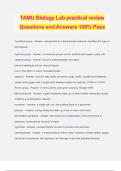
-
TAMU Biology Lab practical review Questions and Answers 100% Pass
- Exam (elaborations) • 13 pages • 2024
- Available in package deal
-
- $12.49
- + learn more
TAMU Biology Lab practical review Questions and Answers 100% Pass functional group - Answer- components of a biochemical molecule, identifies the type of biomolecule hydroxyl group - Answer- a functional group found in alcohols and sugars, polar, OH carbonyl group - Answer- found in carbohydrates, two types terminal aldehyde and an internal ketone one or the other on every monosaccharide carboxyl - Answer- found in fatty acids and amino acids, acidic, double bond between carbon and oxyg...
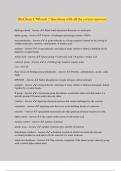
-
BioChem C785 unit 2 Questions with all the correct answers
- Exam (elaborations) • 6 pages • 2024
-
- $11.49
- + learn more
BioChem C785 unit 2 Questions with all the correct answers Hydrogen bond - Answer ️️ -Weak bond interaction Between two molecules amino group - Answer ️️ -Consists of hydorgen and nitrogen atoms (-NH3+) macromolecules - Answer ️️ -A giant molecule in a living organism formed by the joining of smaller molecules: a protein, carbohydrate, or nucleic acid. polymer - Answer ️️ -a long molecule consisting of many similar or identical building blocks linked by covalent bonds Amin...
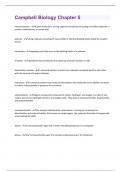
-
Campbell Biology Chapter 5 | 62 Questions with 100% correct answers | Verified and latest
- Exam (elaborations) • 6 pages • 2023
- Available in package deal
-
- $3.99
- + learn more
macromolecules - A giant molecule in a living organism formed by the joining of smaller molecules: a protein, carbohydrate, or nucleic acid. polymer - a long molecule consisting of many similar or identical building blocks linked by covalent bonds monomers - repeating units that serve as the building blocks of a polymer enzymes - specialized macromolecules that speed up chemical reactions in cells dehydration reaction - A chemical reaction in which two molecules covalently bond to each oth...
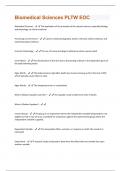
-
Biomedical Sciences PLTW EOC Questions And Answers With Latest Updates
- Exam (elaborations) • 8 pages • 2024
- Available in package deal
-
- $7.99
- + learn more
Biomedical Sciences - The application of the principles of the natural sciences, especially biology and physiology, to clinical medicine. Processing a Crime Scene - 5 parts include photography, sketch, interview, collect evidence, and examine/analyze evidence. Forensic Entemology - The use of insects and bugs to determine when a person died Livor Mortis - The dsicoloration of the skin due to the pooling of blood in the dependent parts of the body following death. Rigor Mortis - The body b...

-
ABCTE Biology Terms Exam 143 Questions with Verified Answers,100% CORRECT
- Exam (elaborations) • 11 pages • 2023
- Available in package deal
-
- $11.99
- + learn more
ABCTE Biology Terms Exam 143 Questions with Verified Answers Acidic solution - CORRECT ANSWER contains more hydrogen ions than hydroxide ions basic solution - CORRECT ANSWER contains more hydroxide ions than hydrogen ions colligative properties - CORRECT ANSWER properties of a solution that depend only on the number of particles dissolved in it, not the properties of the particles themselves. The main ones are boiling point elevation and freezing point depression. boiling point eleva...
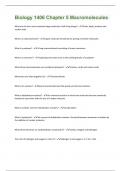
-
Biology 1406 Chapter 5 Macromolecules exam 1 Already Passed!!
- Exam (elaborations) • 4 pages • 2023
- Available in package deal
-
- $2.99
- + learn more
What are the four most important large molecules of all living things? - Carbs, lipids, proteins and nucleic acids What is a macromolecule? - A giant molecule formed by the joining of smaller molecules. What is a polymer? - A long macromolecule consisting of many monomers What is a monomer? - repeating units that serve as the building blocks of a polymer What three macromolecules are considered polymers? - Proteins, carbs and nucleic acids Monomers are inked together by? - Covalent Bonds ...
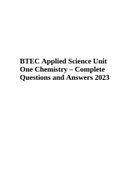
-
BTEC Applied Science Unit One Chemistry – Complete Questions and Answers 2023
- Exam (elaborations) • 18 pages • 2023
-
- $10.49
- + learn more
BTEC Applied Science Unit One Chemistry – Complete Questions and Answers 2023. How many electrons can each orbital hold? correct answerTwo How many electrons can be held in each sub shell? correct answerS - 2 P - 6 D - 10 F - 18 Put the sub shells in order do their energy, lowest to highest correct answerS, p, d and f How do we fill the p and d subshells correct answersingly first and then doubly What is an orbital? correct answerA region of space around the nucleus where there is a 95%...
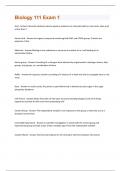
-
Biology 111 Exam 1 Questions & Answers Already Passed!!
- Exam (elaborations) • 9 pages • 2024
- Available in package deal
-
- $7.99
- + learn more
Acid - Answer-Chemical substance whose aqueous solutions are characterized by a sour taste. Have a pH of less than 7. Amino Acid - Answer-An organic compound containing both NH2 and COOH groups. Proteins are polymers of this Adhesion - Answer-Binding of one substance or structure to another as in a cell binding to its extracellular Matrix Amino group - Answer-Consisting of a nitrogen atom attached by single bonds to hydrogen atoms, alkyl groups, aryl groups, or a combination of them Buff...
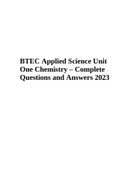
-
BTEC Applied Science Unit One Chemistry – Complete Questions and Answers 2023
- Exam (elaborations) • 18 pages • 2023
-
- $10.49
- + learn more
BTEC Applied Science Unit One Chemistry – Complete Questions and Answers 2023. How many electrons can each orbital hold? correct answerTwo How many electrons can be held in each sub shell? correct answerS - 2 P - 6 D - 10 F - 18 Put the sub shells in order do their energy, lowest to highest correct answerS, p, d and f How do we fill the p and d subshells correct answersingly first and then doubly What is an orbital? correct answerA region of space around the nucleus where there is a 95%...
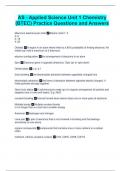
-
AS - Applied Science Unit 1 Chemistry (BTEC) Practice Questions and Answers
- Exam (elaborations) • 5 pages • 2024
-
- $9.99
- + learn more
Maximum electrons per shell Electon shell 1: 2 2: 8 3: 18 4: 32 Orbitals A region in an atom where there is a 95% probability of finding electrons. An orbital can hold a maximum of 2 electrons. electron configuration the arrangement of electrons in an atom Spin Electrons spins in opposite directions. 'Spin up' or 'spin down' Orbital types s, p, d, f Ionic bonding the electrostatic attraction between oppositely charged ions electrostatic attraction the force of attraction...

How did he do that? By selling his study resources on Stuvia. Try it yourself! Discover all about earning on Stuvia


